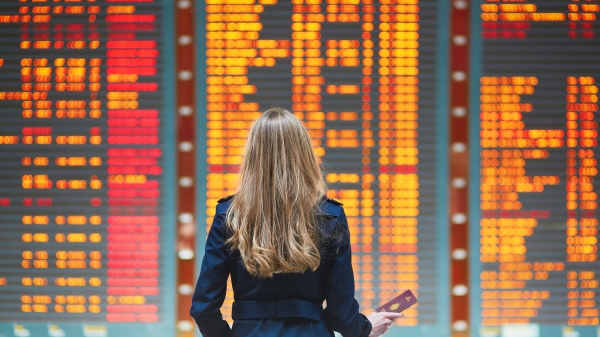Current pandemic is a 'black swan' for economic forecasters, ASU expert says

Every year, Lee McPheters describes the pulse of the economy — which has shown a steady uptick over the past several years for Arizona. McPheters shares his analysis in his role as Research Professor of Economics in the W. P. Carey School of Business at Arizona State University and director of the school’s JPMorgan Chase Economic Outlook Center.
So how do economists, who scrutinize every blip in the statistics, account for a calamity like the COVID-19 pandemic, which has closed businesses and endangered entire sectors of the economy?
The picture is grim. An astounding 3 million jobless claims were filed nationwide over the past week — the highest one-week total in history, according to U.S. Department of Labor statistics released Thursday. In Arizona, more than 29,000 claims were filed for the week ending March 21, compared with about 3,800 the previous week.
McPheters answered some questions from ASU Now:
Question: Have you ever seen anything like this pandemic?
Answer: This is different even from something that would affect a whole state, like (Hurricane) Katrina, which took down the state of Louisiana, or an earthquake in southern California. We’re talking about a global catastrophe.
Have I seen anything like this? No. That’s despite the fact that the common flu has tended to have increasingly greater fatalities in recent years. We have built that into our common understanding of, “This is life in the 21st century and there’s flu, but life and the economy go on.”
Here, the higher fatality rate and the panic response of consumers has really changed everything. So in addition to the economic problems is the overlay of panic on a national scale and apparently on a global scale, in most countries.
Q: So how do economists account for something like this?
A: Economic forecasting models are based on historical relationships among economic variables like income and employment and observed human behavior relative to spending, saving and investing. Forecasting models assume that past relationships, trends and behavior will be continued into the future.
However, forecasters also add the phrase “ceteris paribus,” or “all things remain equal,” and most forecast reports emphasize that the forecast can be affected by what are called “exogenous shocks,” such as war, terrorist attacks, weather catastrophes and most recently, pandemics. These events are regarded as not expected and not part of the forecast.
After the severe recession of 2008, economists adopted the term “black swan,” referring to events that are rare, unpredictable and have wide impact. The financial crisis was a black swan event.
One of the features of a black swan event is that typically, as you start working back through the history, all the analysis suggests we should have seen this coming. Just as California knows they’re going to get another earthquake and they need to build structures in anticipation of that, here, in hindsight, we should have had much better and wider investment in public health.
Q: So is it too soon to predict what will happen with the economy?
A: We don’t have very many indicators that have a high level of frequency. The stock market is a daily indicator and that’s why it has so much attention. As the disease has spread, it’s changing day by day and we’re focused on the stock market telling us how the economy is doing. But the stock market is disconnected from the real economy, which is jobs and output and production.
One indicator that economists focus on is initial claims for unemployment insurance. Most Americans are in the unemployment insurance system. Their employers pay into the system and when you’re laid off, you have the ability to file for a claim. Those claims are filed every week.
Across the country, we’ve seen a huge jump. In Arizona, we’ve been seeing about 3,000 claims a week, and now it’s up around 30,000. We saw it first in Nevada and Washington, states that were hit earlier than Arizona.
Arizona’s labor force is about 3.5 million people. So 1% is 35,000. So if 35,000 file for unemployment, the unemployment rate goes up by 1%. That might continue for several weeks.
Arizona has been running at about 4.5% unemployment and I expect that to double.
Q: What about other segments of the Arizona economy?
A: The big picture is to look at the drivers of the Arizona economy and one of the drivers is population growth. A big portion of our population growth is made up of people moving here from other states. Last year we were the second highest destination for people who were moving from one state to another. About 83,000 people moved here. Well, people aren’t moving right now. There has been pent-up demand for housing, but I think that with in-migration grinding to a complete halt, it will have an effect on construction.
What I think we’ll see possibly is smaller businesses failing, which means commercial space available in more of the strip malls and smaller square footage offices and retail spaces because it will be hard for them to start back up. That’s why there’s a tremendous emphasis on trying to stop small businesses from failing because they employ a large percentage of people working in this country.
Q: The new federal aid plan that’s expected to be approved provides for a $1,200 payment to many Americans. Will that help?
A: This has been done before. It was done in 2001 and in 2008 and economists writing in economic journals, which are not widely read, show that in both cases, only about 20% of that stimulus money was spent on consumer goods and services. About 50% was spent paying off bills. About 30% held onto the money because they thought things would get even worse than they were. So the effect of mailing people a thousand dollars may not be that a thousand dollars gets into the spending stream.
We can’t say if that will be the case now.
Q: And what about all those empty store shelves?
A: You’re getting into the world of psychology there. People feel they need to do something to try to control circumstances and they believe they can do this by buying toilet paper. There is no reason to believe there is a shortage, from my understanding. The problem is in the stocking and, to some extent, the distribution. There’s no reason to think there will be physical damage to production.
Panic buying in and of itself is somewhat of a black swan. It was totally unexpected by grocery stores and retail outlets but I guess in hindsight, they should have thought that like in a hurricane, people will empty the shelves.
Q: What could recovery look like?
A: If we see that, during that second and third quarter, the economy loses jobs, once the turnaround comes, there will probably be a rapid rehiring of all the people laid off. It’s what economists call a V-shaped recession, a sharp dropping down and a strong comeback.
For the 2008 recession, it took Arizona about seven to eight years to come back. Here, I would expect that we will see a comeback probably in the early part of 2021, based on history and what we saw in previous sharp downturns. I looked at some numbers for the 1918 flu, and when the recovery got going, it was only a couple of years to get back to the prior level of employment.
But all bets are off. We just don’t know.
In the long run, we still won’t be able to incorporate this sort of thing. But the hope is, as we did with the financial crisis, after we get out of this, we’ll say, “What could we as a country do better to prepare for this sort of thing?”
Top image: Lee McPheters is Research Professor of Economics in the W. P. Carey School of Business at Arizona State University and director of the school’s JPMorgan Chase Economic Outlook Center. Photo by Charlie Leight/ASU Now
More Business and entrepreneurship

Why consumers are flying high this holiday season
A few years ago, the airline industry was in serious trouble.The COVID-19 pandemic crippled travel, and U.S. airlines received $54 billion in taxpayer bailouts, according to the U.S. Department of…

Being kind with in-kind donations
Charities and nonprofits with retail stores must walk a fine line when accepting in-kind donations from the public.If they turn away items they can’t use, they could appear ungrateful. But if they…

ASU Chandler Innovation Center supports students, local entrepreneurs
Justin Hillsten knows about trying something over and over until it works.The Arizona State University alum and entrepreneur has worked through many iterations of his ventures, thanks to his access…